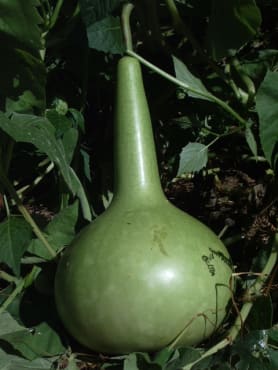(120 days) Open-pollinated. Rampant crawling vines produce large gourds with bulbous base and narrow neck, usually with a bulge at the stem end. Grow 14" tall and up to one foot in diameter. Green rind turns white or starts to brown upon maturity. When dried, make durable bottles or birdhouses. Black Benefit Sharing. ②
Large Bottle or Birdhouse Large Gourd
Large Bottle or Birdhouse Large Gourd
(120 days) Open-pollinated. Rampant crawling vines produce large gourds with bulbous base and narrow neck, usually with a bulge at the stem end. Grow 14" tall and up to one foot in diameter. Green rind turns white or starts to brown upon maturity. When dried, make durable bottles or birdhouses. Black Benefit Sharing. ②
Additional Information
Curing Lagenaria Gourds is Easy
Hardshell gourds are 90% water at harvest. They need to be cured or dried, a slow process of evaporation through the outer shell, which is covered by a thin ivory-green skin. Curing can take 6 weeks to 1 year (average time 4 months) depending on gourd size, thickness of shell, weather and storage conditions.
Immature gourds (that have not developed a thick shell) will rot after harvest. Mature gourds are large and weighty. To cure, store off the ground in a well-ventilated room or unheated outbuilding. For a smooth beige surface, scrape off the outer skin after it loosens and darkens. (Freezing and thawing loosens the outer skin.) Outer skin, if left on, may become moldy; mold-patterned skin will dry to the gourd shell and can be sanded off, painted over or incorporated into the decoration.
Large Gourds
- About 100-140 seeds/oz.
- Days to maturity are from transplant. Originated in tropical Africa.
Culture: Very long season: hardshell gourds must be started indoors 4 weeks before transplanting after last frost. Use row covers and low tunnels to help maturity and reduce insect damage. To improve germination, sandpaper or clip off the radicle end and soak seed. Do not disturb the roots. Vines will grow slowly for a few weeks after transplanting. Once they take off, these rampant crawlers are noted for their enormous foliage, more velvety in texture than that of other cucurbits, and their large white almost luminous night-blooming flowers. Heavy feeders, they will take up huge amounts of garden space unless trellised.
Gourds
All gourds are open-pollinated.
Gourds come in two major categories (Luffa is a third). The small ones are Cucurbita pepo var. ovifera, known as ornamental gourds for their variety of shapes, colors and surfaces. These vigorous viners will usually mature in our climate if direct-seeded. The larger ones are Lagenaria siceraria or hardshell gourds, named from the Greek lagenos, ‘a flask,’ and sicera, ‘an intoxicating drink.’ Lagenaria lack the color range of their smaller cousins, but fascinate with their magical shapes. Because of their hard shells they are the type most commonly used for crafts, musical instruments and utensils.
Germination Testing
For the latest results of our germination tests, please see the germination page.
Our Seeds are Non-GMO

All of our seeds are non-GMO, and free of neonicotinoids and fungicides. Fedco is one of the original companies to sign the Safe Seed Pledge.


